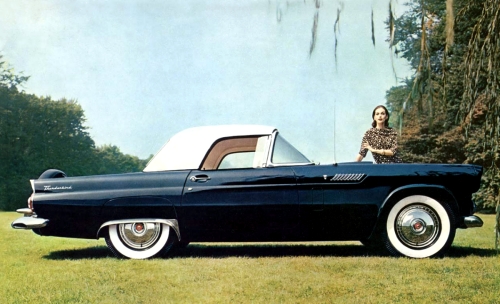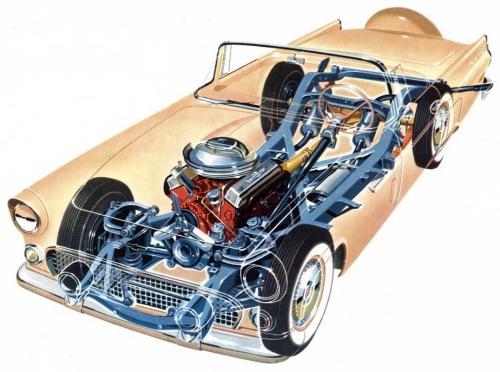| SPECIFICATIONS |
ENGINE CODE
|
ENGINE DETAILS
|
| M |
Conventional or Overdrive Transmission:
Displacement: 292 CID
Bore and Stroke:3.75 x 3.30 in.
Compression Ratio: 8.40:1
Brake Horsepower: 202 @ 4600 rpm
Torque: 289 lbs.-ft. @ 2600 rpm
Carburetor: Holley 4000 four barrel |
Optional:
P |
Conventional Transmission:
Displacement: 312 CID
Bore and Stroke: 3.80 x 3.44 in.
Compression Ratio: 9.5:1
Brake Horsepower: 260 @ 4600 rpm
Torque: 344 lbs.-ft. @ 2600 rpm
Carburetor: Two Holley 4000 4V
(Dealer installation, not factory)
Overdrive Transmission:
Displacement: 312 CID
Bore and Stroke: 3.80 x 3.44 in.
Compression Ratio: 8.4:1
Brake Horsepower: 215 @ 4600 rpm
Torque: 317 lbs.-ft. @ 2600 rpm
Carburetor: Holley 4000 four barrel
Ford-O-Matic Transmission:
Displacement: 312 CID
Bore and Stroke: 3.80 x 3.44 in.
Compression Ratio: 9.0:1
Brake Horsepower: 225 @ 4600 rpm
Torque: 324 lbs.-ft. @ 2600 rpm
Carburetor: Holley 4000 four barrel |
TRANSMISSION CODE
|
TRANSMISSION DESCRIPTION
|
| -- |
Standard: 3-speed Synchromesh with helical gears
Ratios: 2.32:1 (first); 1.48:1 (second); 1:1 (third); 2.82:1 (reverse)
Optional Overdrive: Planetary overdrive with planetary gears
Ratio: 0.70:1
Cut-In Speed: 27 mph
Cut-Out Speed: 21 mph
Optional Automatic: Ford-O-Matic torque converter with planetary gears
Ratios: 1.48:1 (drive); 2.44:1 (low); 2.0:1 (reverse)
|
|
|
REAR AXLE CODE
|
REAR AXLE RATIO
|
| -- |
3.73:1 (standard/synchromesh)
4:10:1 (optional; standard synchromesh)
3.92:1 (standard/overdrive)
3.31:1 (Ford-O-Matic) |
|
|
TIRE SIZE |
BRAKES
|
6.70 x 15 4-ply BSW Tubeless
Wheels: 5 inch
Wheel studs: 5.5 inch
Wheel stud circle: 4.5 inch diameter
|
Front: 11 inch hydraulic drum
Rear: 11 inch hydraulic drum
Total Swept Area: 175.5 sq. in. |
|
|
WHEELBASE
|
DIMENSIONS
|
102 inches
Front Tread: 56 inches
Rear Tread: 56 inches
Original Tire Brand: Firestone
Optional Whitewall Width: 2-11/16"
|
Length: 185.1 inches
Width: 70.3 inches
Height: 50.2 inches
Trunk:
Ground Clearance: 5.9 inches
Height to Top of Door: 34.2 inches
Height to Top of Hard Top: 52.2 inches
Front Leg Room: 45.1 inches
Front Shoulder Room: 53.3 inches
Front Hip Room: 58.8 inches
Front Headroom: 33.1 inches (Hardtop) |
| STEERING |
CAPACITIES
|
Turning Diameter: 36 ft.
Turns Lock-To-Lock: 3.5
Steering Ratio: 23.0:1
Steering Wheel Diameter: 17 inches
Weight Distribution (%; F/R): 49.4/50.6 |
Fuel Tank: --
Cooling System: 19 quarts |
| SPECIAL NOTES |
In its second year, the trend-setting
Thunderbird introduced two of its most memorable and endearing styling
features: the port windows (portholes) in the hard top, and the rear
spare tire carrier (Continental kit).
Both of these items were introduced for practical reasons,
the port windows to improve vision out of the car and the rear spare
tire carrier to increase luggage space in the trunk.
The rear-mounted spare tire carrier would last just one year, due to the handling issues it created. |
1956 changes:
- 12-Volt electrical system
- New Thunderbird emblem design on exterior
- Deep dish, 3-spoke safety design steering wheel
- First year for front fender vents
- Zippered rear window on convertible top (except early 1956 production)
- Port windows on hard top
- Exhaust outlets in rear bumper ends
- Round heater knobs
- Rear spare tire carrier
- Vented gas cap
- Ford Lifeguard Design safety features
- Wing windows on front door
- Ridge under headlamp door
|
|
1956 THUNDERBIRD:
INTRODUCING PORT WINDOWS TO THE WORLD AND A REAR SPARE TIRE CARRIER OUT BACK

Above: 1956 Ford Thunderbird in Raven Black
with a Colonial White hard top. Notice the exhaust outlets in the side
of the rear bumper, and the profile view of the rear spare tire carrier.
The optional full wheel covers, white sidewall tires, two tone paint,
and rear fender shields really give the car a dressed up appearance.
After a very successful debut year, Ford anticipated selling
20,000 Thunderbirds in 1956. Over 16,000 '55 T-birds had been sold, far
more than the 10,000 marketing expected. This would not be the case in
1956, however, and there were several reasons for that, including a late
introduction date due to problems with the rear spare tire carriers in
production. 1955 was a very good year for the auto industry, and an
excellent year to introduce a new model. There were some initial
criticisms of the new T-bird, specifically lack of luggage space in the
trunk, a warm passenger compartment, and blind spots with the
convertible top or hard top installed. It's likely that these issues
cost Ford a few sales. And for 1956, the Thunderbird's main competitor,
the Chevrolet Corvette, got its act together and made big improvements,
introducing a new V-8 engine and creature comforts such as roll-up
windows instead of the plastic side curtains. Some feel that the
introduction of the T-bird actually saved the Corvette, because
Chevrolet put additional time and money into the car to make it more
competitive. Without the added competition, the Corvette might have been
discontinued, but Chevy didn't want to admit defeat to Ford at that
time, so it made the Corvette a better car than it had been.
1956 represented the introduction of two iconic Thunderbird
styling features: the port window and the rear spare tire carrier. Both
were the result of complaints from 1955 Thunderbird owners and potential
owners, who needed more storage space in the trunk and wanted better
rear vision when driving. Both are now historic classic styling touches
in motordom.
Advertising for 1956 continued to use the
Thunderbird as a tie in to the regular Ford line, noting how all Fords
had Thunderbird styling and performance. The little T-bird was without
question the star of the Ford line up at the time, an honor it would
carry for many years to come. Exterior paint and interior trim colors
were expanded for 1956, which allowed more variety in color
combinations, and presented customers with the opportunity to better
customize the car to suit their needs. The hard top could be ordered in a
contrasting color for 1956, and customers could choose whether they
wanted the port hole windows or not, Ford didn't charge extra for them
if they were specified. Most customers loved the new windows and orders
for hard tops with them far exceeded those without the new windows. The
T-bird was stylish, sporty, luxurious, colorful, and offered enough
options so the purchaser could get pretty much exactly what they wanted.
While the 1955 and 1956 models look very similar, in truth many
changes were made during 1955 production and even more changes were
made before the '56 models went into production, as well as during
production of the '56 cars. Among these changes were new weather seals,
in an attempt to stop leaks around the convertible top or hard top, but
nothing really seemed to work.

Above: Skeleton view of the 1956 Ford Thunderbird. |


